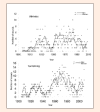Women and Men in Sport Performance: The Gender Gap has not Evolved since 1983
- PMID: 24149688
- PMCID: PMC3761733
Women and Men in Sport Performance: The Gender Gap has not Evolved since 1983
Abstract
Sex is a major factor influencing best performances and world records. Here the evolution of the difference between men and women's best performances is characterized through the analysis of 82 quantifiable events since the beginning of the Olympic era. For each event in swimming, athletics, track cycling, weightlifting and speed skating the gender gap is fitted to compare male and female records. It is also studied through the best performance of the top 10 performers in each gender for swimming and athletics. A stabilization of the gender gap in world records is observed after 1983, at a mean difference of 10.0% ± 2.94 between men and women for all events. The gender gap ranges from 5.5% (800-m freestyle, swimming) to 18.8% (long jump). The mean gap is 10.7% for running performances, 17.5% for jumps, 8.9% for swimming races, 7.0% for speed skating and 8.7% in cycling. The top ten performers' analysis reveals a similar gender gap trend with a stabilization in 1982 at 11.7%, despite the large growth in participation of women from eastern and western countries, that coincided with later- published evidence of state-institutionalized or individual doping. These results suggest that women will not run, jump, swim or ride as fast as men. Key pointsSex is a major factor influencing best performances and world records.A stabilization of the gender gap in world records is observed after 1983, at a mean difference of 10.0% ± 2.94 between men and women for all events.The gender gap ranges from 5.5% (800-m freestyle, swimming) to 36.8% (weight lifting).The top ten performers' analysis reveals a similar gender gap trend with a stabilization in 1982 at 11.7%.Results suggest that women will not run, jump, swim or ride as fast as men.
Keywords: World records; best performances; elite sport; gender difference.
Figures





Similar articles
-
Case Studies in Physiology: Male to female transgender swimmer in college athletics.J Appl Physiol (1985). 2023 Apr 1;134(4):1032-1037. doi: 10.1152/japplphysiol.00751.2022. Epub 2023 Mar 17. J Appl Physiol (1985). 2023. PMID: 36927141 Free PMC article.
-
Olympic cycle periodicity in women's long and triple jumping performance between 1996 and 2019.PLoS One. 2023 Jun 8;18(6):e0286641. doi: 10.1371/journal.pone.0286641. eCollection 2023. PLoS One. 2023. PMID: 37289762 Free PMC article.
-
Analysis of 10 km swimming performance of elite male and female open-water swimmers.Springerplus. 2013 Nov 12;2:603. doi: 10.1186/2193-1801-2-603. eCollection 2013. Springerplus. 2013. PMID: 24324922 Free PMC article.
-
Sex Differences in Swimming Disciplines-Can Women Outperform Men in Swimming?Int J Environ Res Public Health. 2020 May 22;17(10):3651. doi: 10.3390/ijerph17103651. Int J Environ Res Public Health. 2020. PMID: 32456109 Free PMC article. Review.
-
Trends in Triathlon Performance: Effects of Sex and Age.Sports Med. 2013 Sep;43(9):851-63. doi: 10.1007/s40279-013-0067-4. Sports Med. 2013. PMID: 23797729 Review.
Cited by
-
Does the sex difference in competitiveness decrease in selective sub-populations? A test with intercollegiate distance runners.PeerJ. 2015 Apr 21;3:e884. doi: 10.7717/peerj.884. eCollection 2015. PeerJ. 2015. PMID: 25922790 Free PMC article.
-
Sports Participation and Osteoarthritis in Females: A Systematic Review.Sports (Basel). 2023 Dec 31;12(1):15. doi: 10.3390/sports12010015. Sports (Basel). 2023. PMID: 38251289 Free PMC article. Review.
-
The exercise sex gap and the impact of the estrous cycle on exercise performance in mice.Sci Rep. 2018 Jul 16;8(1):10742. doi: 10.1038/s41598-018-29050-0. Sci Rep. 2018. PMID: 30013130 Free PMC article.
-
The influence of sex, age, and race experience on pacing profiles during the 90 km Vasaloppet ski race.Open Access J Sports Med. 2016 Feb 18;7:11-9. doi: 10.2147/OAJSM.S101995. eCollection 2016. Open Access J Sports Med. 2016. PMID: 26937207 Free PMC article.
-
Sex difference in race performance and age of peak performance in the Ironman Triathlon World Championship from 1983 to 2012.Extrem Physiol Med. 2012 Dec 14;1(1):15. doi: 10.1186/2046-7648-1-15. Extrem Physiol Med. 2012. PMID: 23849215 Free PMC article.
References
-
- Berthelot G., Thibault V., Tafflet M., Escolano S., El Helou N., Jouven X., Hermine O., Toussaint J.F. (2008) The Citius End: World Records progression announces the completion of a brief ultra-physiological quest. PLoS ONE 33(2). Available from URL: http://www.plosone.org - PMC - PubMed
-
- Cheuvront S.N., Carter R., Deruisseau K.C., Moffatt R.J. (2005) Running performance differences between men and women: an update. Sports Medicine 35, 1017-1024 - PubMed
-
- Courtenay W.H. (2000) Constructions of masculinity and their influence on men's well-being: a theory of gender and health. Social Science and Medicine 550, 1385-1401 - PubMed
-
- Cureton K., Bishop P., Hutchinson P., Newland H., Vickery S., Zwiren L. (1986) Sex difference in maximal oxygen uptake. European Journal of Applied Physiology and Occupational Physiology 54, 656-660 - PubMed
LinkOut - more resources
Full Text Sources
Miscellaneous
